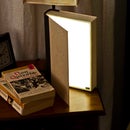Introduction: Hand Lights
I like to work on stuff in my living room, because that's where all the comfortable furniture and the good music system is. Unfortunately there's not a ton of light. I tried a task light but it got uncomfortably warm and cast harsh shadows. I tried the head mounted lamps like the cool DJ's wear, but I didn't like where I had to hold my head to see my work.
So I made these. They'll give you light right where you hands are, wherever you move them. Wearing one on both arms makes sure there's always enough light on everything, and they're pretty light and comfy. I've worn them for hours without noticing. And the little arms are adjustable so you can tweak where the light goes. Just be careful scratching your nose, they're bright enough they'll hurt if you look into them at close range.
I've been using them for carving and working on electronics. But I think it would be cool to make a couple with UV LEDs and break out the blacklight paint for DJing.
These instructions are for making one, but you'll probably want two.
Time: Less than an hour
Skills needed: Basic soldering, hot gluing, wire stripping etc.
Total cost: About $8-12, including the batteries.
Thanks!
I managed to be one of the winners in the Get the LED Outcontest! Thanks everyone for their support!
Parts:
- 1 Battery holder for 3 AAA batteries.
- 3 AAA batteries.
- 1 mini toggle switch. (SPST. Skip this if your battery holder has a switch, or you just want to turn it off by taking the batteries out.)
- 18 inches of 2 conductor stranded wire. 20 gauge or so.
- 18 inches of Velcro. Hook or loop.
- 1 inch of Velcro (the mate of the Velcro above)
- 3 White LEDs: (I used 3, 7000mcd 3.5v, 25mA LEDs, though fewer, brighter LEDs would work too.)
- 3 resistors, 47 ohm. (Or whatever your LEDs need. Check here.)
- 18 inches of 9 or 11 1/2 gauge aluminum wire. AKA armature wire.
- Solder
- Hot glue
- Electrical tape/heat shrink tubing.
Tools:
- Soldering iron.
- Hot glue gun.
- Wire cutter/strippers.
- Pliers.
- Scissors.
Step 1: Collect All Your Parts and Tools.
Parts:
- 1 Battery holder for 3 AAA batteries.
- 3 AAA batteries.
- 1 mini toggle switch. (SPST. Skip this if your battery holder has a switch, or you just want to turn it off by taking the batteries out.)
- 18 inches of 2 conductor stranded wire. 20 gauge or so.
- 18 inches of Velcro. Hook or loop.
- 1 inch of Velcro (the mate of the Velcro above)
- 3 White LEDs: (I used 3, 7000mcd 3.5v, 25mA LEDs, though fewer, brighter LEDs would work too.)
- 3 resistors, 47 ohm. (Or whatever your LEDs need. Check here.)
- 18 inches of 9 or 11 1/2 gauge aluminum wire. AKA armature wire.
- Solder
- Hot glue
- Electrical tape/heat shrink tubing.
Tools:
- Soldering iron.
- Hot glue gun.
- Wire cutter/strippers.
- Pliers.
- Scissors.
Step 2: Create the Support Arm
First I put little pieces of electrical tape over the visible metal bits of the battery holder to prevent shorts from our armature wire. Don't use too much tape because it'll conflict with the hot glue we use later. (You want to apply hot glue to the plastic, not to the tape.) Skip this step if you're using a less cheap battery case.
Take the armature wire and bend it around 3 1/3 sides of the battery case. It should generally be snug, but leave a small (1/8") gap along the "inside back". That's the side that will be closest to your chest and closest to your shoulder. (This is where an image is worth a thousand words.) That gap is where you'll secure the adjustable strap, so make sure your Velcro strap will fit through it. Note that this one is a right handed light. For a left handed one wrap the wire the other way.
When you're happy with it, hot glue it in place. Make sure you don't put any glue on the part where the strap will go. And don't get any glue inside or you'll have a hard time getting batteries in.
Step 3: Wire Up Your LEDS.
Solder the resistors to your LEDs.
Since 4.5 volts is too much for most LEDs you need to put a resistor in there to keep them from burning out.
In most cases a 47 ohm resister on each will work. Use the LED resistor calculator here to be sure. (The values for my LEDS: 4.5 volts, 3.5 forward volts, 25mA forward current, and 3 LEDs.)
It doesn't matter if you put them on the long or short end of the LED, just put them all on the same end so you don't get mixed up and have to spend 20 minutes desoldering them. (Like I did.)
Now would be a good time to check them with your battery pack to make sure you've got it right, The long end of the LED goes to the +, short to -.
If they all check out then solder the three LEDs together. (Or if you got one big, bight LED you skip this step.) Solder all the free ends of the LEDs together along with one side of your two conductor wire. Similarly connect the free ends of the resistors together with the other strand of your wire.
Apply some electrical tape or shrink tubing to prevent short circuits.
Now would be a good time to test it again and make sure they all light up and you don't have any short circuits.
Step 4: Create the Velcro Strap
Make sure you have enough Velcro to fit around your forearm with a several inches to spare. For me 15 inches was enough, but I don't spend lots of time at the gym.
Hook or loop doesn't matter, as long as you have a long piece of one and a short piece (an inch or so) of the other.
Hot glue one end of the long strip to the bottom of the battery enclosure. Make sure it's hook or loop side facing the battery holder. Put it on the "up the arm" end, furthest away from where the armature wire sticks out, and pointing away from our little gap we left for our strap. Again, the picture is worth a thousand words.
When the glue cools, put the strap through the strap hole we left in step one. Then hot glue the short bit near the end of the strap. Leave about 1/2 inch to make it easier to pull off. Glue it on the hook or loop side, not the smooth side. (You could also stitch it, but the glue gun is already hot...)
You should now have an adjustable strap that will secure it to your arm.
Give it a try, put your arm through the strap and see how it fits.
Step 5: Finish Connecting the LEDs
While you're trying the strap out, bend the remaining bit of the armature wire to a goodBrontosaurus neck shape, and cut it to length. For my arms I found that I liked the lights about 6 inches from the back of my hand, which meant trimming the wire to about 6 inches from the front of the battery case.
When you find a length you like, hot glue the lights in place and wrap the trailing wire around the armature a few times to keep it out of the way.
Step 6: Connect the Switch
Note for the lazy : You can get a battery enclosure with a built in switch, or simply skip the switch and just take the batteries out to turn it off. But why wouldn't you want to add a toggle switch? Toggle switches are awesome.
Connect your switch between one of the leads from the battery holder and your LEDs. Connect the other battery lead directly to the LED wire.
Again check to make sure that everything is wired the right way before soldering into place.
Try to keep the leads as short as possible so you don't have to worry about them catching on stuff. If you have extra wire you can wind it around the armature wire before soldering.
Hot glue the switch into place. I also covered the wire with glue to prevent shorts, keep it from catching on stuff, and because hot glue is one of the most fun ways to get first degree burns.
Step 7: Use!
Put it on your arm and fire it up! Tweak the position of the armature wire and make the individual LEDs to make sure they direct light where you want. I wear them just below the elbow, half way between the inside and side of the arm.
And lastly: Make another one, they work better in pairs. And your second one will go much faster.
Step 8: Become a Master of Hand Lights
*If I have extra patches to hand out. Which I do.
Masters of Hand Lights
- nolte919 who made these rocking lights.
Runner Up in the
Get the LED Out! Contest
Participated in the
Get the LED Out! Contest













